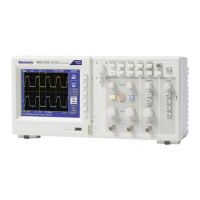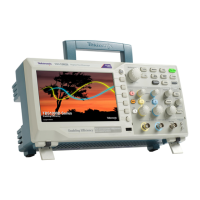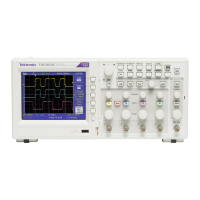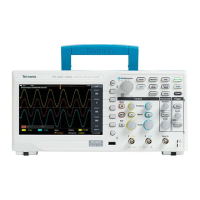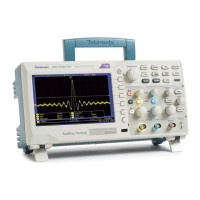6. Push the Ch1 side menu. The pop-up menu of measurement types appears to
the left. .
7. Turn the Multipurpose knob to highlight Peak-Peak.
8. Push the Multipurpose knob to select Peak-Peak. A check should appear
next to the menu item and the peak-to-peak for channel 2 should appear
towards the bottom of the display.
9. Read the displayed peak-to-peak amplitudes for both channels.
10. To calculate the amplifier voltage gain, use these equations:
VoltageGain = output amplitude/input amplitude
VoltageGain (dB) = 20 × log 10 (VoltageGain)
Using autorange to examine a series of test points
If you have a machine that is malfunctioning, you may need to find the frequency
and RMS voltage of several test points, and compare these values to ideal values.
You are not able to access front-panel controls since you need to use both hands
when probing test points that are difficult to physically reach.
1. Push the 1 (channel 1 menu) button.
2. Push Probe ► Voltage ► Attenuation. Chose the attenuation of the probe
attached to channel 1 from the pop-out selectable list of values by turning and
pushing the Multipurpose knob.
3. Push the Autoset button for more than 1.5 seconds to activate autoranging,
and select the Vertical and Horizontal option.
4. Push the Measure button to see the Measure Menu.
5. Push Ch1.
6. Turn the Multipurpose knob to select Frequency.
7. Push Ch2.
8. Turn the Multipurpose knob to select Cycle RMS.
9. Attach the probe tip and reference lead to the first test point. Read the
frequency and cycle RMS measurements from the oscilloscope display and
compare these to the ideal values.
10. Repeat the preceding step for each test point, until you find the
malfunctioning component.
NOTE. When Autorange is active, each time you move the probe to another test
point, the oscilloscope readjusts the horizontal scale, the vertical scale, and the
trigger level, to give you a useful display.
Application examples
TBS1000B and TBS1000B-EDU Series Oscilloscopes User Manual 33
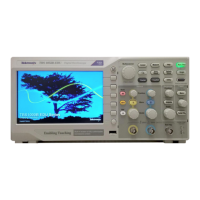
